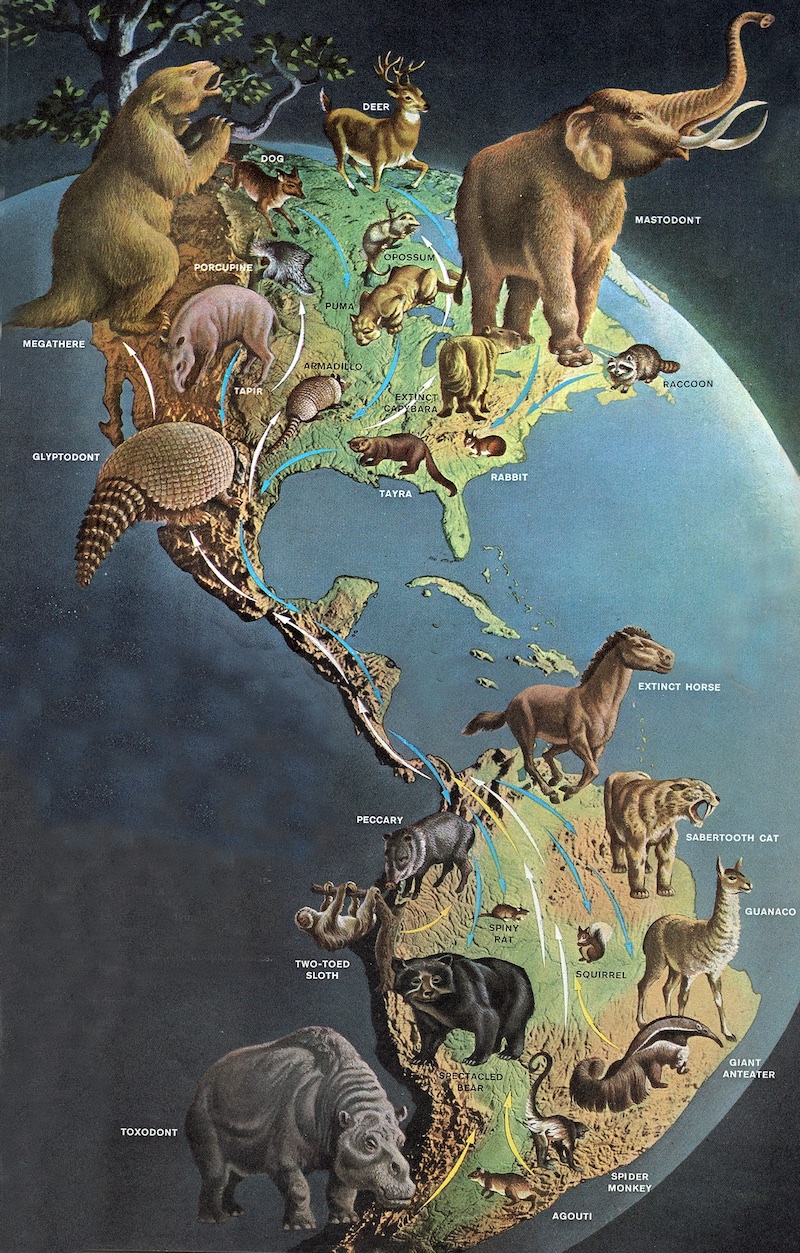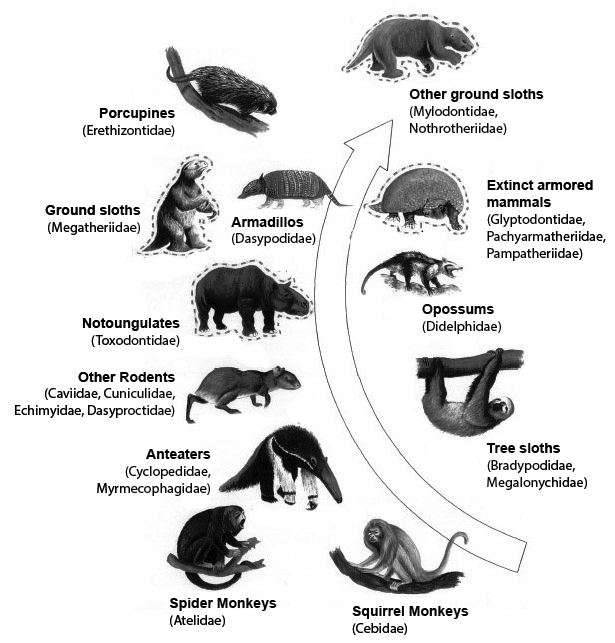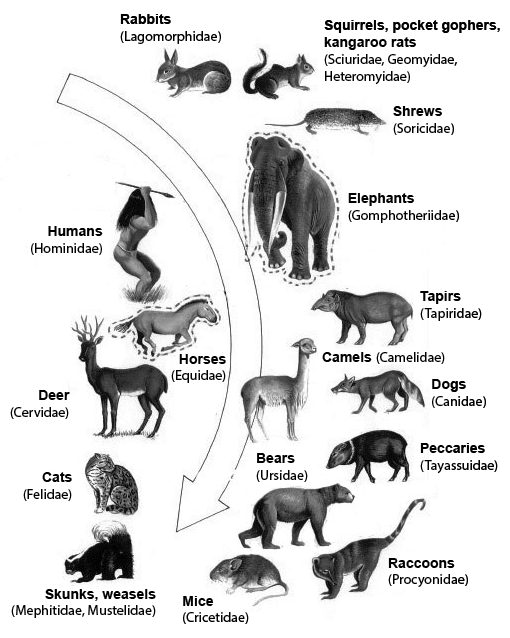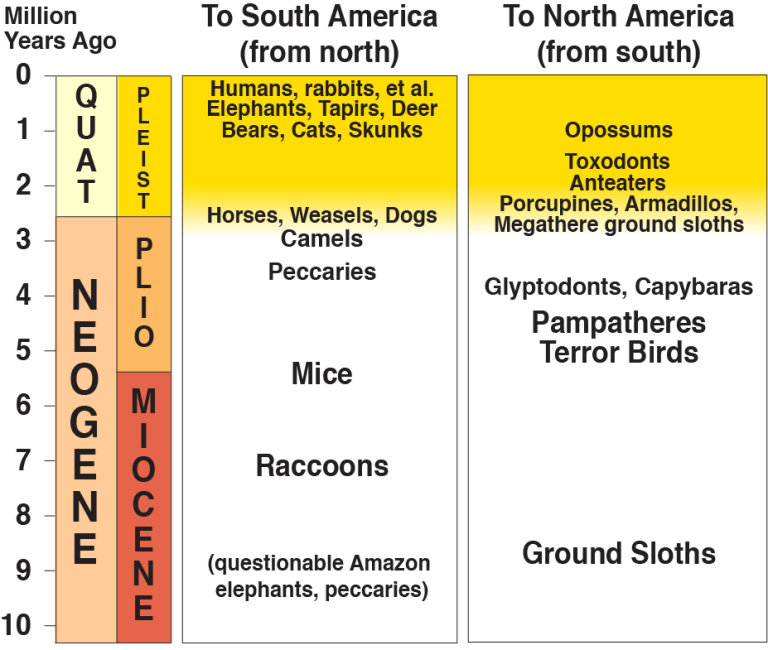The other day, I was tagged in a Tweet asking when the Great American Biotic Interchange (aka GABI) began. In short, there is no simple answer; it mainly depends on your definition.
If you are not familiar with the GABI, it is the name given to the large-scale exchange of animals (particularly land-dwelling mammals) that took place between North and South America at the end of the Cenozoic (the chunk of geologic time since giant dinosaurs went extinct). Because this exchange mainly involved animals (as opposed to plants), it is sometimes referred to as the GAFI, which substitutes “Faunal” (animals) for “Biotic” (all life). However, GABI was coined first, and GAFI sounds like a role on a movie set, so GABI is the acronym more frequently used. Sometimes “Biotic” is left out altogether, making it the Great American Interchange, but who wants to say GAI? I’m going with GABI.

In temperate North America, the effects of the GABI were pretty minimal, at least from today’s perspective. Animals like the North American porcupine, the Virginia opossum, and the nine-banded armadillo are all southerners that came north via present-day Panama, but these represent only a small proportion of the mammals you can find in North America today. A handful of large to giant mammals also made it to North America but later went extinct about 12,000 years ago. These included several types of giant sloths, a glyptodont, a capybara, and even a notoungulate.
South American immigrants had a bigger impact in Central America and what is now southern Mexico; modern mammal communities in these areas include several types of opossums, monkeys, anteaters, tree sloths, and some neat neotropical rodents known as agoutis, spiny rats, and pacas. Many of these animals attract tourists to places like Costa Rica for wildlife viewing but are relative newcomers to the area themselves.

In South America, North American immigrants had a heyday and are now diverse and abundant in both tropical and temperate areas. These include a wide variety of carnivorans (such as the jaguar, maned wolf, bush dog, coati, spectacled bear, and tayra, just to name a few) and hoofed mammals (tapirs, camels such as guanacos and alpacas, and deer like the pudu and brocket deer) as well as the most successful but least conspicuous group (unless you are really looking): sigmodontine rodents, which include hundreds of species of small South American rats and mice. Humans also immigrated to South America during the GABI, as did elephants, shrews, rabbits, squirrels, kangaroo rats, and horses.

The GABI was facilitated by the formation of Isthmus of Panama, which is the land connection that now joins the Americas. You may be surprised to learn that it hasn’t always been there. It probably existed in some form around the end of the Mesozoic Era (the time of Tyrannosaurus and Triceratops), but this was long before the mammals we are talking about existed; shortly after of the “Age of Mammals” began, the connection between the Americas disappeared. Thus, North and South America were separated by ocean for tens of millions of years, making crossings between them difficult (though not impossible) for most non-flying mammals for some 60 million years.
When did the land connection between the Americas form again? That is difficult to know. However, we have some good indirect evidence. A wide variety of North American mammals appear in South America for the first time around 2.6 million years ago, and the same is true for South American mammals in North America. This pattern only makes sense if these mammals were able to walk between the two continents. Thus, all scientists agree that a solid land connection existed by about 2.6 million years ago (the end of the Pliocene).
Nevertheless, a small minority of mammals made their interamerican journey earlier, during the Pliocene or even during the late Miocene.* For example, two types of sloths made it to North America by 9 million years ago, and by around 5 million years ago, a different sloth, a pampathere (an extinct relative of armadillos), and a large terror bird (incapable of flight) were living there. Glyptodonts and capybaras followed soon thereafter. In South America, an extinct relative of North American raccoons made it to Argentina by around 7 million years ago, mouse-like sigmodontine rodents arrived there by 5 million years ago, and peccaries got there by about 3.5 million years ago.**

Do these early immigrants indicate that a solid land connection between the Americas exited earlier, during the Pliocene or even late Miocene? Probably not – though some geologists would disagree (based on other data). Many of these early-dispersing mammals belong to groups that are known to have crossed other ocean barriers in the past. Therefore, it has been argued that they did the same thing between the Americas; instead of walking across a dry isthmus, they fortuitously crossed the ocean barrier separating the Americas, perhaps facilitated by a series of small islands. This seems to be a very reasonable explanation for sloths and small rodents and probably also an omnivorous, semi-arboreal mammal like Cyonasua (the raccoon relative). It is a bit more difficult to envision a pampathere making the crossing, though I wouldn’t consider it impossible. I’m not so sure about a terror bird.
If you don’t think a lucky ocean crossing sounds like a very good explanation, then it is worth thinking about the alternative scenario; how plausible is it that a solid land connection existed long before 2.6 million years ago and only these few groups decided to make the crossing? I would say it is much less plausible than a terror bird crossing before a solid land connection existed. The land bridge has undoubtedly acted like a “filter” to some extent – many successful North American mammal groups never dispersed to South America – but the fact that most mammal groups made the crossing starting around 2.6 million years ago is a striking (and well-established) pattern in the fossil record.
Returning to our main question, when did the GABI begin?
For some researchers, the Great American Biotic Interchange did not begin until lots of immigrant mammals are recorded in both South and North America about 2.6 million years ago, around the end of the Pliocene. Although there was interchange prior to this time, it wasn’t “great.”
For me, interchange is the operative word, and the natural mixing of these faunas on a continental scale is what makes it “great.” Therefore, when I talk about the GABI, I say that it started some 9 million years ago, during the late Miocene. The pattern of the GABI is clearly a continuum of interchange, ranging from a trickle in the late Miocene to a deluge in the Pleistocene. I see no compelling reason to designate a specific point along this continuum as the point at which is becomes “great,” particularly given the vagaries of the fossil record.
Regardless of one’s definition, there is no question that the GABI is among the greatest “natural experiments” in faunal mixing that ever took place!
* Interestingly, a rafting monkey made its way from South America to North America during the early Miocene, about 20 million years ago, but it was apparently unsuccessful in establishing primates as long-term residents of Central America.
** In recent years, remains of a gomphothere (an extinct relative of elephants) and peccaries from eastern Peru have been claimed to be at least 9 million years old, which would push back the first appearances of these groups back to the late Miocene. These claims have yet to be fully accepted by the scientific community, and the specimens may be Pleistocene in age.
References and Further Reading:
- Alberdi, M. T., J. L. Prado, and R. Salas. 2004. The Pleistocene Gomphotheriidae (Proboscidea) from Peru. Neues Jahrbuch für Geologie und Paläontologie – Abhandlungen 231:423-452.
- Bloch, J. I., E. D. Woodruff, A. R. Wood, A. F. Rincon, A. R. Harrington, G. S. Morgan, D. A. Foster, C. Montes, C. A. Jaramillo, N. A. Jud, D. S. Jones, and B. J. MacFadden. 2016. First North American fossil monkey and early Miocene tropical biotic interchange. Nature 533:243-246.
- Cione, A. L., G. M. Gasparini, E. Soibelzon, L. H. Soibelzon, and E. P. Tonni. 2015. The Great American Biotic Interchange. A South American Perspective. Springer Briefs in Earth System Sciences. Springer, Amsterdam, Netherlands, 97 pp.
- Frailey, C. D., and K. E. Campbell. 2012. Two new genera of peccaries (Mammalia, Artiodactyla, Tayassuidae) from Upper Miocene deposits of the Amazon Basin. Journal of Paleontology 86:852-877.
- Montes, C., A. Cardona, C. Jaramillo, A. Pardo, J. C. Silva, V. Valencia, C. Ayala, L. C. Pérez-Angel, L. A. Rodriguez-Parra, V. Ramirez, and H. Niño. 2015. Middle Miocene closure of the Central American Seaway. Science 348:226-229.
- O’Dea, A., H. A. Lessios, A. G. Coates, R. I. Eytan, S. A. Restrepo-Moreno, A. L. Cione, L. S. Collins, A. de Queiroz, D. W. Farris, R. D. Norris, R. F. Stallard, M. O. Woodburne, O. Aguilera, M.-P. Aubry, W. A. Berggren, A. F. Budd, M. A. Cozzuol, S. E. Coppard, H. Duque-Caro, S. Finnegan, G. M. Gasparini, E. L. Grossman, K. G. Johnson, L. D. Keigwin, N. Knowlton, E. G. Leigh, J. S. Leonard-Pingel, P. B. Marko, N. D. Pyenson, P. G. Rachello-Dolmen, E. Soibelzon, L. Soibelzon, J. A. Todd, G. J. Vermeij, and J. B. C. Jackson. 2016. Formation of the Isthmus of Panama. Science Advances 2:e1600883.
- Pascual, R. 2006. Evolution and geography: the biogeographic history of South American Land Mammals. Annals of the Missouri Botanical Garden 93:209-230.
- Webb, S. D. 1985. Main pathways of mammalian diversification in North America; pp. 201-217 in F. G. Stehli, and S. D. Webb (eds.), The Great American Biotic Interchange. Plenum Press, New York.
- Webb, S. D. 1991. Ecogeography and the Great American Interchange. Paleobiology 17:266-280.
- Woodburne, M. O. 2010. The Great American Biotic Interchange: dispersals, tectonics, climate, sea level and holding pens. Journal of Mammalian Evolution 17:245-264.

I was wondering why the horse and elephant have a hyphenated line around them in the graphic depicting north to South America migration?
LikeLike
That line indicates that they went extinct after arriving in South America, unlike all of the other groups, which survived (or have living representatives there).
LikeLike